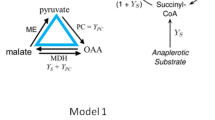Abstract
Using compartmental analysis methods, a mathematical basis is given for the measurement of absolute and fractional cardiac output with diffusible tracers. Cardiac output is shown to be the product of the blood volume and the sum of the rate constants of tracer egress from blood, modified by a factor reflecting transcapillary diffusibility, the transfer fraction. The return of tracer to the blood and distant (intracellular) events are shown to play no role in the solution. Fractional cardiac output is the ratio of the rate constant of tracer egress from blood to an organ, divided by the sum of the egress constants from blood. Predominantly extracellular ions such as sodium or bromide are best suited for this technique, although theoretically any diffusible tracer whose compartmental model can be solved may be used. It is shown that fractional cardiac output is independent of the transfer fraction, and therefore can be measured accurately by tracers which are not freely diffusible.
Similar content being viewed by others
References
W. G. Walker, and W. S. Wilde. Kinetics of radiopotassium in the circulation.Am. J. Physiol. 170:401–413 (1952).
N. D. Charkes, P. T. Makler, Jr., and C. Philips. Studies of skeletal tracer kinetics. I. Digital-computer solution of a five compartment model of18F-fluoride kinetics in humans.J. Nucl. Med. 19:1301–1309 (1970).
N. D. Charkes, M. Brookes, and P. T. Makler, Jr. Studies of skeletal tracer kinetics. II. Evaluation of a five-compartment model of18F-fluoride kinetics in rats.J. Nucl. Med. 20:1150–1157 (1979).
N. D. Charkes, M. Brookes, and P. T. Makler, Jr. Radiofluoride kinetics. In L. Colombetti (ed.),Principles of Radiopharmacology, Vol. III. CRC Press, Boca Raton, Fla., 1979, pp. 225–242.
R. Wootton. The single-passage extraction of18F in rabbit bone.Clin. Sci. Mol. Med. 47:73–77 (1974).
A. Gellhorn, M. Merrell, and R. M. Rankin. The rate of transcapillary exchange of sodium in normal and shocked dogs.Am. J. Physiol. 142:407–427 (1944).
R. A. Shipley and R. E. Clark.Tracer Methods for in vivo Kinetics. Academic Press, New York, 1972, pp. 215–220.
V. V. Sagar, J. M. Piccone, and N. D. Charkes. Studies of skeletal tracer kinetics. III. Tc-99m (SN) methylenediphosphonate uptake in the canine tibia as a function of blood flow.J. Nucl. Med. 20:1257–1261 (1979).
P. J. Kelly and J. B. Bassingthwaighte. Studies on bone ion exchanges using multiple-tracer indication-dilution techniques.Fed. Proc. 36:2634–2639 (1977).
P. T. Makler, Jr., and N. D. Charkes. Studies of skeletal tracer kinetics. IV. Optimum time delay for Tc-99m (Sn) methylenediphosphonate bone imaging.J. Nucl. Med. 21:641–645 (1980).
L. A. Sapirstein. Regional blood flow by fractional distribution of indicators.Am. J. Physiol. 193:161–168 (1958).
H. C. Conn, Jr., and J. Goldberg. Accuracy of a radiopotassium dilution (Stewart Principle) method for the measurement of the cardiac output.J. Appl. Physiol. 7:542–548 (1955).
P. L. Altman and D. S. Dittmer.Biology Data Book, 2nd ed., Vol. III. Fed. Am. Soc. Exp. Biol., Bethesda, MD., 1974, p. 1700.
J. L. Patterson, Jr., R. H. Goetz, J. T. Doyle, J. V. Warren, O. H. Gaver, D. K. Detweier, S. I. Said, H. Hoernicke, M. McGregor, E. N. Keen, M. H. Smith, Jr., E. L. Hardie, M. Reynolds, W. P. Flau, and D. R. Waldo. Cardiorespiratory dynamics in the ox and giraffe, with comparative observations on man and other mammals.Ann. N.Y. Acad. Sci. 127:393–413 (1965).
V. P. Popovic and K. M. Kent. 120-day study of cardiac output in unanesthetized rats.Am. J. Physiol. 207:767–770 (1964).
Author information
Authors and Affiliations
Rights and permissions
About this article
Cite this article
Charkes, N.D. Mathematical basis for the measurement of absolute and fractional cardiac output with diffusible tracers by compartmental analysis methods. Journal of Pharmacokinetics and Biopharmaceutics 12, 517–524 (1984). https://doi.org/10.1007/BF01060129
Received:
Revised:
Published:
Issue Date:
DOI: https://doi.org/10.1007/BF01060129




